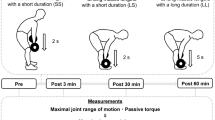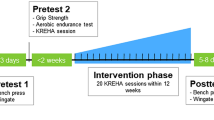Summary
Negative and positive work performed during leg extension movements of 53 well trained subjects was measured with the help of a special dynamometer. The subjects performed four maximal push off trials against five different loads (25–105 kg): two two-legged extensions from a squatting position (SM) with a knee angle of 70‡ and two trials with a preliminary counter movement (CM) but with the same extension range as in the SM. Positive work differed only by about 4% between CM and SM in spite of large differences in initial forces at the onset of concentric contraction. Based on simulations, it is suggested that in CM the advantage of stored elastic energy can almost completely be nullified by the disadvantage of a limited shortening distance of the contractile elements. It is hypothesised that elastic energy in CM can only cause considerable extra work during concentric contraction compared to the maximal positive work done in SM if the total range of lengthening and shortening of the muscle(s) involved is larger in CM than in SM
Similar content being viewed by others
References
Alexander RMN, Bennet Clark HC (1977) Storage of elastic strain energy in muscle and other tissues. Nature 265:114–117
Asmussen E, Bonde Petersen F (1974) Storage of elastic energy in skeletal muscles in man. Acta Physiol Scand 91:385–392
Avis FJ, Hoving A, Toussaint HM (1985) A dynamometer for the measurement of force, velocity, work and power during an explosive leg extension. Eur J Appl Physiol 54:210–215
Bober T, Jakolsky E, Nowacki Z (1980) Study on eccentricconcentric contraction of the upper extremity muscles. J Biomechanics 13:135–138
Bosco C, Komi PV (1979) Potentation of the mechanical behaviour of the human skeletal muscle through pre-stretching. Acta Physiol Scand 106:467–472
Bosco C, Komi PV, Locatelli E (1979) Physiologische Betrachtungen zum Tiefsprungtraining. Leistungssport 9:434–439
Bosco C, Komi PV, Ito A (1981) Prestretch potentiation of human skeletal muscle during ballistic movement. Acta Physiol Scand 111:135–140
Bosco C, Ito A, Komi PV, Luhtanen P, Rahkila P, Rusko H, Viitasalo JT (1982) Neuromuscular function and mechanical efficiency of human leg extensor muscles during jumping exercises. Acta Physiol Scand 114:543–550
Cavagna GA, Dusman B, Margaria R (1968) Positive work done by a previously stretched muscle. J Appl Physiol 24:21–32
Cavagna GA, Citterio G (1974) Effect of stretching on elastic characteristics and the contractile component of frog striated muscle. J Physiol 239:1–14
Cnockaert JC, Pertuzon E, Goubel F, Lestienne F (1978) Series elastic component in normal human muscles. In: Asmussen, E, JØrgensen K (eds) Biomechanics VI-A. International series on Biomechanics, vol. 2A, University Park Press, Baltimore, pp 68–72
Hill AV (1970) First and last experiments in muscle mechanics. Cambridge
Ingen Schenau GJ van (1984) An alternative view of the concept of utilisation of elastic energy in human movements. Hum Movement Sci 5:301–336
Komi PV, Bosco C (1978) Utilisation of stored elastic energy in leg extensor muscles by men and women. Med Sci Sports 10:261–265
Steben RE, Steben AH (1981) The validity of the stretch shortening cycle in selected jumping events. J Sports Med 21, 28–30
Author information
Authors and Affiliations
Rights and permissions
About this article
Cite this article
Avis, F.J., Toussaint, H.M., Huijing, P.A. et al. Positive work as a function of eccentric load in maximal leg extension movements. Europ. J. Appl. Physiol. 55, 562–568 (1986). https://doi.org/10.1007/BF00421653
Accepted:
Issue Date:
DOI: https://doi.org/10.1007/BF00421653




